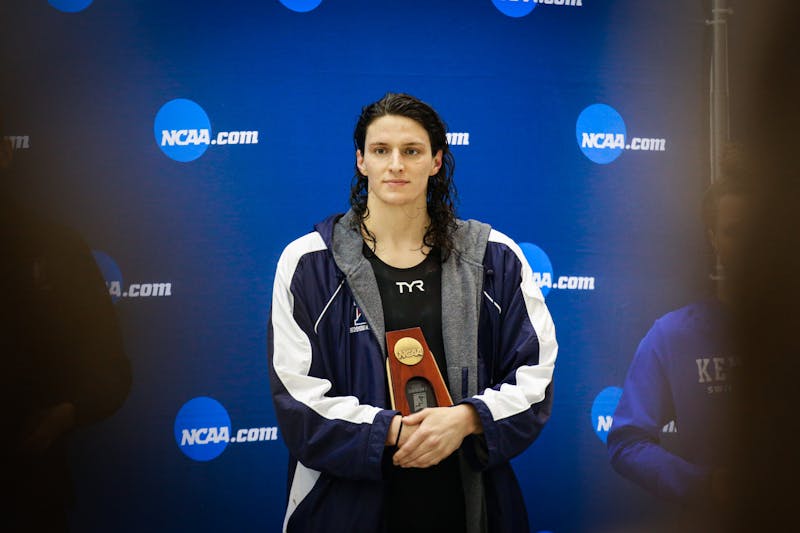and AMITY ZEH We've all seen them - this strange breed of humanity which, come rain or wind tirelessly takes to the streets and gyms on a quest for self-improvement. What leads this breed to embrace physical pain and agony over the relative comforts of inactivity? Why would people possibly allow themselves to be drawn away from the pleasures of slacking? For some, working out is a practical means of relieving stress. Such is the case with Emily Goodwin, a Wharton freshman, who says her running workout is habit by now and that she enjoys the added bonus of weight loss. She tries to run at least four times a week, depending on her schedule, for up to an hour each time. Not all of her motives for exercise are as admirable as her actual determination, however. "The amount I run is directly proportional to the amount of beer I drink," she said. Still, Goodwin said she has come to rely on her daily run as a tension breaker and looks forward to it as a study break. Exercise works to increase student's energy levels and feelings of wellbeing, as well. Connie Fang, a Wharton junior, said working out "makes me feel better about myself. I get out all my stress, plus I like to see the improvement." Fang tries to achieve a balance between muscular development and cardiovascular fitness by using the Nautilus machines and Stairmaster five times a week if possible for up to two hours each session at the Penn Fitness Center in Hutchinson Gym. The rigorous regimen, Fang says, "gives me energy, and if I don't work out this much, I lose the benefits of past workouts." Though students might be enthusiastic about working out, they are less than pleased with area facilities. The inconvenient location of the Penn Fitness Center and the inadequate and outdated equipment are a major deterrent to working out, they say. Laurie Ross, a College freshman, feels strongly about the gyms. "They suck," she explains. "The machines are OK, but the room is tiny, it's really crowded and they need a water cooler." Ross, however, along with many other students, is serious in her desire to lose weight and stay in shape, and continues to use the fitness center because of its price and comparative availability. There are many other options for the self-motivated fitness enthusiast at Penn. Other facilities provided by the university at Hutchinson and Gimbel Gyms include squash courts, saunas and steam room, basketball courts, badminton courts and a swimming pool -- so many, in fact, that its a wonder more people don't get off their lazy butts and go. Moreover, outside of university-offered programs, there is University City Nautilus at 4009 Locust, the place to see and be seen while you sweat. Facilities there include the ever popular Stairmasters and Lifecycles, as well as treadmills, Nordic Tracks and free-weights, as well as more than two complete cycles of Nautilus machines. Also, this gym tries to offer a modicum of a training program. Bob Stern, the general manager, explains, "We like to give you close one-on-one training. It's safer and it provides better results." But perhaps more importantly to the money conscious as well as image conscious enthusiast, University City Nautilus offers special students rates by semester, as well as a yearly student rate. Countless students, however, opt for the most traditional form of exercise, available to them without fees, hours or crowded gyms -- running. And for Ellen Hennessy, a sophomore in the School of Nursing, running is a means of escape from our daily backdrop called West Philadelphia. "It's great to get off campus and explore the city," she tells. "I really love to run by the art museum and Boathouse Row." Fitness is not always an end in itself, but, for some, a means to achieve greater competitiveness. Just look at Penn heavyweight crew rower Jeff Spencer, a sophomore in the College of Arts and Sciences. For Spencer, who has been rowing since he was a freshman in high school, crew and fitness go hand in hand. Long workouts are "a real time commitment," Spencer admits, but in the end, "it's worth it, I really love it." In season, Spencer spends two hours a day on the water, covering up to twelve miles a day. On top of that, he and his teammates are expected to engage in weight training three times a week. And you thought that Stairmaster was bad. In the weight room, the workout consists of a variety of heavy lifting aimed to build muscle, as well as calisthenics for full body endurance. All this hard work pays off, as the men's heavyweight crew team is one of the most competitive teams at Penn, as well as one of the top two or three crew teams in the country. Of course, other competitive sports teams at Penn, like the football team, work just as hard to play just as well. Chris Johnson, a junior at Wharton and a nose guard for the Penn team, works out winter and summer alike, not to mention during the football season. "Our conditioning is geared for short bursts, 10-yard sprints, that type of thing." Johnson and his teammates measure the success of their workout with success on game day. Dartmouth, Fordham and Bucknell probably wish they did a few less situps. Penn students in general seem to be very conscious of their health and appearance and many view exercise as a twofold blessing - muscle toning and weight loss on the physical side, and tension relief on the mental side. What students might not know is what options are available to them, or how to begin. The concept of "exercise" to the non-initiated may seem formidable at first, but believers explain it quickly becomes a way of life -- if you want it to be.
The Daily Pennsylvanian is an independent, student-run newspaper. Please consider making a donation to support the coverage that shapes the University. Your generosity ensures a future of strong journalism at Penn.
DonatePlease note All comments are eligible for publication in The Daily Pennsylvanian.







